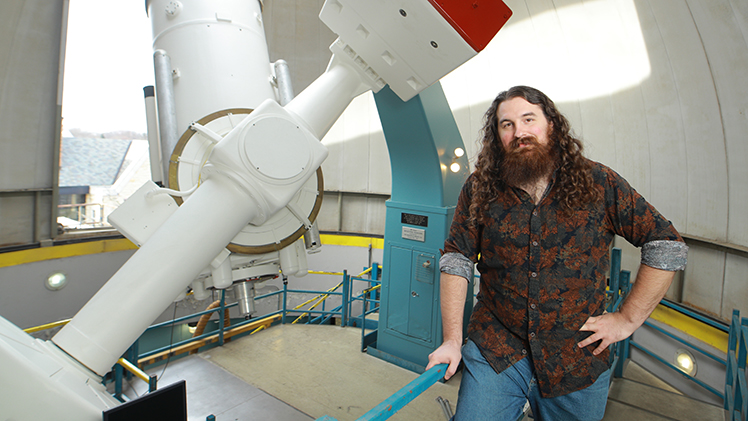Sam Beiler watched the James Webb Space Telescope launch with bated breath on Dec. 25, 2021.
“I was sitting with my nephew, and I had to tell him, ‘I will answer your questions in a second. I need to make sure nothing goes wrong with this launch,’ ” he recalled. “There were a thousand tiny steps that needed to all happen perfectly for this thing to unfold itself in space.”

Sam Beiler, a doctoral student in physics, is the first author on a research article presenting the first nearly complete spectral energy distribution of a Y dwarf.
Beiler was perhaps more invested than the average stargazer. The doctoral student in physics with a concentration in astrophysics was counting on using the space telescope to gain new insights into brown dwarfs alongside Dr. Michael Cushing, his advisor and a professor in The University of Toledo’s Department of Physics and Astronomy.
Beiler is now the first author on an initial research article based on the data from a first-cycle observational program on the James Webb. Beiler, Cushing and their collaborators presented the first nearly complete spectral energy distribution of a Y dwarf in the Astrophysical Journal Letters in July. Beiler and Cushing are continuing to work on a wider sample, in yet another indication that research into the universe’s coldest stars is heating up with the latest-and-greatest in space telescopes.
“It’s been really exciting,” Beiler said. “I feel fortunate to be at UToledo and working with Dr. Cushing, and to have this chance to work with the James Webb.”
Beiler is one of several graduate and undergraduate students who have had a front-row seat to some of the earliest data to come out of the James Webb. The University ranked No. 6 among worldwide institutions in successful proposals for the first cycle of scheduled observing time, with projects led by four faculty astronomers and one former doctoral student making the cut.
Dr. Rupali Chandar, professor and associate chair of the Department of Physics and Astronomy, also was awarded 12 hours for a project in the second cycle.
These successful proposals have opened groundbreaking opportunities for the student researchers with whom these faculty work. Beiler, for example, has been working with Cushing from proposal to publication, including working with simulation software to translate big-picture objectives into the nitty-gritty instructions: Where exactly should they point the telescope? For how long?
“Sam has been integral to this program from its inception and has taken the lead in executing it,” Cushing said.
Beiler, originally from Mifflinburg in Central Pennsylvania, said the opportunity to study under Cushing attracted him to UToledo in 2019.
Cushing was part of a team of astronomers who discovered the coolest class of brown dwarfs, which themselves are substellar objects somewhere between a star and a planet, in 2011. Y dwarfs, as this extra-cool class is known, are characterized by a temperature of less than 600 Kelvin — in some cases as low as a relatively comfortable 300 Kelvin, or 80 degrees Fahrenheit.
Beiler had been fascinated by brown dwarfs since he completed a research project related to them at Bucknell University, while he was an undergraduate student in physics at Grove City College in Pennsylvania. The experience pushed him first toward a minor in astronomy, and ultimately what he hopes will be a post-doctoral position in academia after his defense of a still in-the-works thesis.
Brown dwarfs, and Y dwarfs, specifically, have proven tricky to observe. Because they’re so cold, they emit most of their light on the same infrared wavelengths as Earth. That makes them difficult to observe from ground-based telescopes, although ground-based telescopes as well as other space telescopes had provided limited data prior to the James Webb.
But the James Webb, which detects near-infrared and mid-infrared wavelengths, expands and improves the dataset significantly.
“The upgraded precision is huge. We can estimate the temperature of brown dwarfs by analyzing the light that they emit, and our temperature estimates are five-fold better now than they were before the James Webb,” Beiler said. “We’re also finally seeing continuous spectra, rather than having to piece together bits and pieces of spectra using other telescopes.
“We’re no longer trying to understand an elephant by looking at its tail,” Beiler continued, offering an analogy. “We can now see the whole thing.”
Beiler’s and Cushing’s initial research that appears in the Astrophysical Journal Letters looks specifically at the Y dwarf identified as WISE J0359—54, and is based on just two and a half of the 75 first-cycle observation hours Cushing was allocated on the James Webb. Beiler and Cushing are now building on this dataset, including with the 24-object sample currently in the works.
“This is the tip of the iceberg when it comes to what we will learn with these data,” Cushing said.